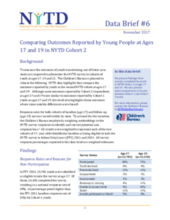Displaying 1761 - 1770 of 2496
This article explores the many obstables and legal challenges that unaccompanied minors are experiencing in the judicial system in the state of Arizona in the US in their efforts to obtain legal status and be granted asylum.
This chapter explores the types of family disruption most commonly associated with various youth diagnostic concerns.
Seventy-eight postinstitutionalized (PI) children adopted at ages 17–36 months were assessed 2, 8, 16, and 24 months postadoption on measures of cortisol and parenting quality, and compared to same-aged children adopted from foster care (FC, n = 45) and nonadopted children (NA, n = 45).
The purpose of this study was to determine the proportion of school moves that can be reduced through implementation of the educational stability provisions of the Fostering Connections to Success and Increasing Adoptions Act (FCA, 2008) and the Every Student Succeeds Act (ESSA, 2015), and to identify opportunities to minimize the number of transitions that children and youth in foster care experience in the US.
In this study, data from the US National Youth in Transition Database were used to evaluate the associations between childbirth at three time points (prior to age 17, ages 17–19, and ages 19–21) and females’ socioeconomic outcomes and risk indicators at age 21 (n = 3173).
The objectives of this study are to: use the methodology of a 2007 study to establish foster care minimum adequate rates for children (MARC) based on the child's age and geographical location in every state; update the MARC with cost of living adjustments to 2016; examine changes in gaps between the MARC and the current foster care rates; and identify states that have made increases to their reimbursement rates, relative to the MARC over time.
The objectives of this study are to: use the methodology of a 2007 study to establish foster care minimum adequate rates for children (MARC) based on the child's age and geographical location in every state; update the MARC with cost of living adjustments to 2016; examine changes in gaps between the MARC and the current foster care rates; and identify states that have made increases to their reimbursement rates, relative to the MARC over time.
This study examined predictions of externalizing behaviors (EB) from childhood to adolescence/young adulthood from temperament, preadoption maltreatment, and adoptive family cohesion.
As debates about immigration roil the national political dialogue in the United States, the CPC Learning Network will host a webinar to discuss the mass exodus of
This data brief presents data highlights that compare the outcomes reported by youth in the second NYTD cohort at ages 17 and 19.

